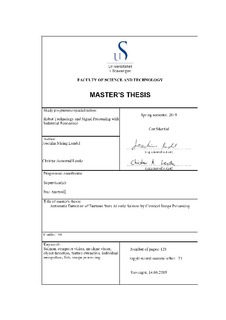| dc.contributor.advisor | Austvoll, Ivar | |
| dc.contributor.author | Aanestad Lende, Christer | |
| dc.contributor.author | Lundal, Joachim Nising | |
| dc.date.accessioned | 2019-11-13T09:11:04Z | |
| dc.date.available | 2019-11-13T09:11:04Z | |
| dc.date.issued | 2019-06-14 | |
| dc.identifier.uri | http://hdl.handle.net/11250/2628076 | |
| dc.description | Master's thesis in Cybernetics and signal Processing / Industrial economics | nb_NO |
| dc.description.abstract | The methods created for this project aim to locate the salmon in the image and extract features from it. The aim of the features are to recognize individual salmon from each other. Individual identification, done by RFID today, is important in the Norwegian aquaculture industry, mostly for scientific purposes. If this could be implemented by machine vision instead, it could be expanded to commercial purposes and tracking of larger masses, which could be economically beneficial for the industry.
Based on reasonable assumptions, some economic scenarios were computed to estimate potential savings that could be achieved by successful implementation of such a system. Based on the assumptions, it is reasonable to believe that this could save roughly 5,04 MNOK every year per offshore fish cage applied to. The potential costs are however somewhat uncertain.
K-means clustering was used to extract the salmon from the image. This was successful for all images. It should be noted that the data-set was cleaned of images which did not meet certain requirements.
A method was developed to detect the nose and tail tips of the salmon mainly to estimate its orientation. It worked on all images largely due to the successful cropping done by the k-means clustering.
Another method was created to detect the pectoral fin on the salmon, using segmentation by thresholding, as well as structural measures and area-thresholds. It achieved a best success rate at 99.2% on 537 images from one data-set(main set) and at worst a success rate of 93.5% on 246 images from another data-set(second set).
It was important to detect the gill-opening on the salmon, which would lead to extract a ROI around the head. The method for locating the gill-opening therefore had an important task in detecting the back of the gills, towards the body, such that the area of the head was not cropped too small. The method had an average of detecting 5.32 pixels away from the gill-opening towards the body, which served the purpose of capturing the head well.
Salmon have spots on their heads, which could serve as matching points for individual specimen. Two methods were tested to detect these spots, one of them created specifically for this project. The methods were merged together and achieved a success rate of 49.02% correctly detected spot with 0.6% false detections on the main with strict parameters. With more tolerable parameters it got a success rate of 87.4% correctly detected. Of all possible detections, it also incorrectly detected 52.01% spots. The same method was tried on the second data-set with success rates at 45.67% correctly and 4.32% false detections with strict parameters and 97.58% correct detections with 50% false detections with tolerable parameters.
An individual recognition method was created, which used feature vectors of each image to recognize if it was the same salmon in two images. The feature vectors contained up to 19 features. There were images of 178 salmon to recognize, and all but 16 had two images of the same specimen. Out of 178 salmon, it recognized 65 of them, a success rate of 36.47%, incorrectly classifying 28.8%. 34.7% of the salmon were not recognized. In other words, out of 340 possible correct classifications, 124 were correctly classified, 98 incorrectly classified and 118 salmon not classified at all. | nb_NO |
| dc.language.iso | eng | nb_NO |
| dc.publisher | University of Stavanger, Norway | nb_NO |
| dc.relation.ispartofseries | Masteroppgave/UIS-TN-IDE/2019; | |
| dc.relation.ispartofseries | Masteroppgave/UIS-TN-ISØP/2019; | |
| dc.rights | Navngivelse 4.0 Internasjonal | * |
| dc.rights.uri | http://creativecommons.org/licenses/by/4.0/deed.no | * |
| dc.subject | informasjonsteknologi | nb_NO |
| dc.subject | akvakultur | nb_NO |
| dc.subject | industriell økonomi | nb_NO |
| dc.title | Automatic Detection of Features from Atlantic Salmon by Classical Image Processing | nb_NO |
| dc.type | Master thesis | nb_NO |
| dc.subject.nsi | VDP::Social science: 200::Economics: 210 | nb_NO |
| dc.subject.nsi | VDP::Technology: 500::Information and communication technology: 550 | nb_NO |

